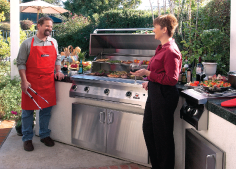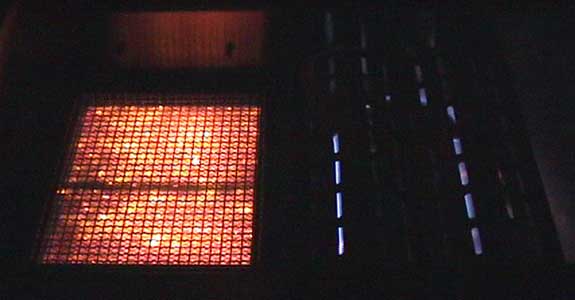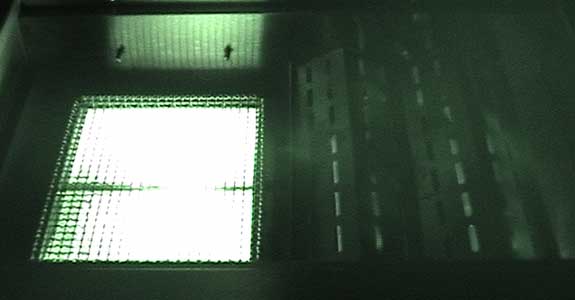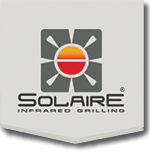 Ever notice that even on a cold day, the sunlight feels warm? The reason for that is infrared energy radiating from the sun and traveling at the speed of light to warm you up as you step outside.Inside every Solaire® gas grill is a special burner that works much the same way. Using infrared radiant energy, Solaire cooks faster (over 50%) and makes food juicier and much more flavorful than traditional grills. In technical terms, it’s the difference between radiance and convection. In practical terms, it’s the difference between ordinary food and extraordinary succulence.
Ever notice that even on a cold day, the sunlight feels warm? The reason for that is infrared energy radiating from the sun and traveling at the speed of light to warm you up as you step outside.Inside every Solaire® gas grill is a special burner that works much the same way. Using infrared radiant energy, Solaire cooks faster (over 50%) and makes food juicier and much more flavorful than traditional grills. In technical terms, it’s the difference between radiance and convection. In practical terms, it’s the difference between ordinary food and extraordinary succulence.
Traditional grill burners produce heat over a relatively small area, and over the long warm-up period, transfer that heat into secondary elements (ceramic rods, lava rock, etc.), in an attempt to evenly heat the grilling area. Unfortunately, hot spots are common and much of the burner heat is reflected downward. The result is circulating hot air that saps the moisture from grilled food.
A Solaire infrared burner heats the food directly using uniform radiant infrared energy. This process doesn’t rely on hot air (remember, sunlight still feels warm after a trip through the vacuum of space), meaning that moisture is trapped as the intense heat quickly sears the food’s surface. Food cooks faster and retains more flavor.
As a bonus, infrared grills are less prone to flare-ups, as what drippings occur are instantly vaporized by the intense heat of the burner and returned to the food in the form of flavor-enhanced smoke.
It’s no surprise that many of the finest steak houses use infrared burner systems to prepare their meats. Grill with a Solaire gas grill just once and you’ll experience the convenience, speed and unmatched taste that only Solaire can offer.
What is Infrared?
In the simplest terms, infrared energy is light that we cannot see, but our bodies can detect as heat. It is part of the electromagnetic spectrum that includes radio waves, X-rays and visible light. All of these forms of energy have a specific frequency, as represented in the chart below.

Infrared energy is comprised of those frequencies that exist just below the red end of the visible spectrum, and for cooking properties they have a very unique benefit – when they strike organic molecules (such as any type of food), they cause the molecules to vibrate, thereby creating heat. Although almost any type of electromagnetic energy can cause heating, for the purpose of cooking, infrared energy is the perfect choice.
RADIANCE VS. CONVECTION
Without getting overly technical, heat transfer can occur one of three ways – conduction, convection or radiation. Conduction requires direct contact between two objects and is used frequently in cooking. Sauteing and pan-frying both rely on conduction to work. Convection relies on heat transfer via a liquid or gas. The heated molecules of air or water physically bump into other molecules, and transfer some of their energy. This process is also regularly used in cooking, whether you are boiling, deep frying or cooking on a conventional gas grill.
Radiant heating is different. It does not rely on any intermediary to conduct heat – it works directly on the molecules in its path. Because of this, it is highly efficient. Any heat transfer involves some loss, so when you have a gas flame, heating air, then heating a radiant, then heating air some more, then finally heating your food (as in a traditional grill), you have much more loss than if that heat energy goes directly from the source to the food being cooked.
SEEING IS BELIEVING
Below is a photo of the firebox of a Solaire InfraVection® grill, taken with a normal camera and with a camera that can detect infrared energy. On the left side is the ceramic infrared burner; on the right is the traditional convection burner.
 View from Standard Camera
View from Standard Camera
 View from Infrared Camera
View from Infrared Camera
There are two important things to notice in the infrared image. First, the IR burner looks much brighter in infrared. This is because the camera is taking the infrared energy and converting it to visible light. Second, notice that the steel vaporizer plate over the convection burner looks brighter in the infrared image also. This is because all hot objects emit some infrared light. As is obvious from the photo, though, some objects emit better than others.
WHY INFRARED IS BETTER FOR GRILLING
When we grill, we are replicating the oldest cooking method known – the open fire. In a natural fire, whatever the fuel being used (wood, charcoal, etc.) there is a tremendous amount of infrared energy being produced. This is easily verified by color. A wood fire burns yellow-orange. Coals glow a dull red. Physics tells us that any heat source will emit light at a wavelength nearest the wavelength of the dominant energy production, so, in simple terms, the redder it gets, the more IR it’s producing. A blue gas flame can’t replicate the open fire experience because it simply produces the wrong “color” of heat.
Another significant benefit of infrared grills is in moisture retention. As we discussed earlier, convection heats by first heating air, then pushing that hot air onto the food. Think for a minute what a hot wind does to your skin. It dries it out. A convection grill is doing the same thing to your food. All that rising hot air carries away a little bit of moisture each time it blows by. Infrared energy has an opposite effect, actually driving moisture away from the surface and deep into the item being grilled. This process enhances flavor and creates a succulence that is difficult to replicate with other cooking methods. Take a look at the complete Benefits of Infrared page for more details.
